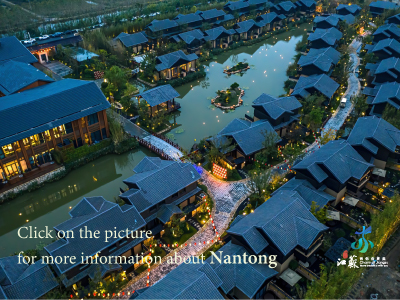THE phrase ‘World Heritage Site’ evokes a simple realisation of what seems to just belong — a destination around the world, and the diamond-encrusted honour of being one of the best examples of “cultural, historical, scientific” significance on earth. However, as the world’s tourism economy expands and contracts, the economic meaning of these destinations takes on a far greater importance to their sphere of influence than just a title. Myles Stedman explains.
UNESCO World Heritage Sites can be as wide-ranging and vague as ‘Rome’ or ‘the Banks of the Seine’, to far more specific examples, such as the Tower of London and the Statue of Liberty. Some sites, such as Vienna’s Schonbrunn Palace, generate greater exposure and a greater windfall for their destination through their listing. Others, such as ‘the works of Anton Gaudi’, includes famous sites such as Park Guell in Barcelona, as well as lesser-known places, such as Casa Mila, which therefore receive greater exposure through association. Either way, a site’s listing is big business; they generate significant economic interest for a country via tourism. Some World Heritage sites will receive visitation purely through a combination of their listing and the Googling skills of nearby tourists; others are some of the most recognisable points on the globe, and as Collette Head of Marketing James Hewlett points out, are set to cash in post-pandemic from hungry, bucket list-quenching travellers. “People absolutely have their particular list of UNESCO World Heritage Sites,” he told travelBulletin. “In our select program of over 180 tours, we’ve got over 250 UNESCO World Heritage Sites…The number of sites that have been designated has grown rapidly over the years, and there are people who want to target a particular UNESCO site”.
A woman who is perhaps as acutely aware of this as any is Ebony Murison, Operations Manager for the Bungle Bungle Savannah Lodge, located near Purnululu National Park, which is home to the Bungle Bungle Range — one of the most-targeted World Heritage sites in Australia. The Bungle Bungle Savannah Lodge operates accommodation, as well as flights and tours.
Murison explained to travelBulletin that, since its tourism development in the early 1980s, and its listing as the first, and still only, World Heritage Site in the Kimberley (this just feels wrong), both domestic and international awareness of Purnululu continued to grow.
Murison said the appeal for her destination is most demonstrable when she attends the Australian Tourism Exchange. “International travel agents flock to the imagery of the Bungles domes,” she described. “They all know it. While our tourism products still typically attract a higher volume of domestic travellers compared to international travellers, in the last few years of COVID, we’ve seen a further increase in domestic visitation and interest”. Murison said international border closures had forced some Australians to explore their own backyard, further awakening local appetites to just what is possible down here. “Australian visitors were aware of the Bungle Bungles, but I suppose it was one of those things that ‘you’d get around to one day'”. Not anymore.
Fortunately, Indigenous Australians are greatly benefited by Purnululu National Park, and other World Heritage sites on country, with both domestic and international tourists hungry to learn about the world’s oldest living culture. Unfortunately, it is not always this simple when it comes to drawing as much benefit as possible for all out of a World Heritage Site. One particular bid was the latest flash point between Japan and South Korea over the former country’s rule over the latter from 1910 to 1945. The Government of Japan recently nominated three gold and silver mines on Sado Island, in the eastern part of the Sea of Japan, for World Heritage designation, hoping to showcase them alongside other Japanese highlights such as Himeji Castle, Itsukushima Shrine, and the historic villages of Shirakawa-go and Gokayama. However, following Japan’s annexation of South Korea in 1910, about 1,500 of the latter country’s citizens were conscripted to work in the mines, alongside many more Japanese. When new Japanese Prime Minister Fumio Kishida announced in January the country would seek World Heritage designation for the sites, the Government of South Korea accused its former ruler of “ignoring the painful history of forced labour,” and called on the bid to be immediately suspended. Meanwhile, on Sado Island, banners and posters celebrate the World Heritage nomination, as local business, far removed from the site’s tragic history, anticipate an influx of visitors upon the showcasing of their own backyard to the world. Tourism would greatly benefit this region, where even before the pandemic, visitor numbers had been modest at best. Sado’s largest mine can see tourists wander through its tunnels, before heading back into town to sample the Island’s seafood, or partake in some of its more active adventures, such as kayaking and hiking. Most locals would be thrilled to see a similar boom to that witnessed by Omori, another Japanese mining region, which was World Heritage listed in 2008, and thereafter drew close to one million visitors the year it was registered. Before that happens though, South Korea is demanding proper recognition of the site’s past, prior to its inclusion on the lucrative World Heritage List.
A similar plan from Croatia to feature inventor Nikola Tesla on its coins has raised temperatures in its neighbour Serbia, which also has long fought for bragging rights regarding the long-dead engineer. Since the resurgence of Tesla’s mainstream popularity in the 1990s, anchored by the 1995 novel The Prestige, and the founding of an electric vehicle company in his name in 2003, these bragging rights have escalated from mere rodomontade to serious international clout — with which come tourism dollars. Tesla was ethnically Serbian but was born in modern-day Croatia (then a part of the Austrian Empire), and ever since his initial rise to fame in the United States, tensions have simmered over his ethno-nationalistic legacy. Well before Croatia’s intent to mint currency in his honour, both countries have dubbed buildings, monuments, streets, holidays, events, and more, in Tesla’s name, in an effort to entice the inventor’s fans to their country. Flying into Serbia’s capital will see you land at Belgrade Nikola Tesla Airport, after which you can visit the World Heritage-listed Nikola Tesla Museum. However, if you cross the border into Croatia, you will find the Nikola Tesla Memorial Center, in his birthplace of Smiljan, and the Nikola Tesla Technical Museum, in the country’s capital Zagreb — where you can also find a Tesla statue. Last July, the Croatian public voted to emblazon Tesla on the country’s new Euro coins, which will slide a Croat Tesla into the pockets of almost half a billion Europeans, further promoting the country’s claim to the man. National Bank of Serbia Governor Jorgovanka Tabakovic promised to take “appropriate steps” with the European Commission. Tabakovic said Croatia’s move would “constitute the appropriation of the cultural and scientific heritage of the Serbian people, because it is indisputable that this famous scientist declared himself, throughout his life, as a Serb by origin and ethnicity”. Serbia itself already mints a Tesla-adorned currency, with which visitors to the country can buy souvenirs decorated with the man’s face from the many stalls lining Belgrade’s streets, which sell t-shirts, mugs, refrigerator magnets, and other gifts. Would Croatia’s move to strike its own coins with Tesla threaten these takings? Potentially — and Serbia is not prepared to find out.
World Heritage scuffles are nothing new, and in some cases, it doesn’t even take two countries to tango — just one. A recent World Heritage Submission from Italy is dividing the country, with the nation unable to agree upon the honours for its espresso coffee-brewing method. Seeking World Heritage status for espresso under the “Intangible Cultural Heritage of Humanity” banner, the Italian submission was objected to by Neapolitans in the country’s south, who claim the method originated in their part of the nation, and therefore, the submission should recognise their region only, not the country in its entirety. To make matters worse, the more holistic Italian UENSCO bid came from the country’s north, which bears comparatively little cultural similarity to Napoli, and draws a very different style of tourist, such as those arriving for ski holidays, or to marvel at the architecture of cities such as Venice and Milan. Not long before the coffee contention, a video promoted the southern region of Calabria (which neighbours Napoli) as an idyllic, picturesque tourist spot – in contrast to the north, which the campaign positioned as unsafe for travel due to pollution and COVID-19. The campaign drew backlash from politicians and tourism stakeholders in the north, who frequently spar with their southern compatriots, particularly Napoli. In addition to its tangible historic tourism assets such as Mt. Vesuvius and the Archaeological Areas of Pompeii, Herculaneum, & Torre Annunziata, Napoli does a roaring trade off the back of its billing as the “home of Italian food”, such as Neapolitan pizza, Neapolitan ice cream & spumoni, and of course, Neapolitan espresso. This does not go unnoticed by the north, with those attempting to celebrate Italian coffee as a whole suggesting of the south, “they want to say that coffee comes from Naples, but such prevarication is unacceptable. It means appropriating something which isn’t only theirs, it is ‘also’ theirs”. However, any UNESCO-related hit to the south’s billing would be “an act of war by the north against the south”, according to one Italian scholar.
Italy’s espresso market is worth an estimated 5 billion, according to The Wall Street Journal, but its cultural and tourism importance goes far beyond that, and hence, is bitterly fought for & defended. In fact, in similar areas which produce iconic foods — think Scotch whisky, Mexican tequila, and Parmesan cheese — tour operators, both local and international, run fit-for-purpose regional holidays, so travellers can get a first-hand experience of the product at its source, whether it be Champagne’s sparkling wine, Dijon’s mustard, or Swiss cheese. These designations too are heavily protected, and as Collette’s James Hewlett explains, they have been particularly sought after, especially in recent years, as tourists want to further immerse themselves culturally while travelling. “One of our newer tours features a Scotch whisky distillery on [Scotland’s] West coast, and people are interested in those moments, as well as participation and experiencing, as opposed to just looking, which has been a thing for several years now,” he explained. “In terms of the guest experience, and really wanting to get closer and have a closer understanding, rather than just take pictures. People want to really sort of get up close and personal, and that’s exactly how we’ve built up to improve it.”
As much as UNESCO giveth, such as in Purnululu’s case, it can also taketh away. Liverpool’s Maritime Mercantile City was last year stripped of its World Heritage site status, after multiple warnings from UNESCO. In 2012, the site was added to the Organization’s List of World Heritage in Danger due to the 5.5 billion large-scale Liverpool Waters redevelopment. In 2017, UNESCO again warned Liverpool its status was at risk of being revoked in light of soccer team Everton FC’s proposed 550 million stadium at Bramley-Moore Dock, which is incorporated into the Liverpool Waters project. English Heritage also declared the developments would render some of Liverpool’s most significant historic buildings “severely compromised”, and the archaeological remains of parts of the historic docks “at risk of destruction”. Regardless, the stadium was ratified, and as a result, UNESCO voted to revoke the site’s World Heritage status. Public feelings were mixed, with Liverpool City Council saying the moratorium on construction within the site was impractical. However, Liverpool’s tourism stakeholders, which trade heavily off the city’s good cultural name, believe differently. Visit Liverpool now only lists the city’s designation as a ‘UNESCO City of Music’ on its website. Gone are the mentions of Liverpool’s former designation as a ‘European Capital of Culture’. Liverpool’s Liberal Democrat leader Richard Kemp said it was a “day of shame” for the city, adding that it would “without a doubt, affect our tourism and inward investment”.
Similar fears may be in the process of being realised at home, with the Great Barrier Reef long a target of concern from UNESCO and its List of World Heritage in Danger. The Organisation first took aim in 2017, when it published a draft decision expressing serious concern about the impact of a mass coral bleaching event at the Reef the year prior. The draft also warned Australia the country would not meet the targets of the Reef 2050 Plan without considerable work to improve water quality. Last year, UNESCO moved further, recommending the Reef be placed on the ‘in Danger’ List — the first time a site would have made the list chiefly because of impacts from climate change. Intensive lobbying from Australia delayed the “in danger” listing, with the Australian Government saying UNESCO should not be used as a mechanism to encourage action on matters such as global warming. A decision on the matter will be considered again at a meeting later this year, when one of Queensland’s greatest tourism assets could take its biggest hit ever. One of Australia’s most popular destinations both domestically and internationally, the Reef not only carries the water for tourism economies in its immediate sphere, such as the Whitsunday Islands and the Cairns regions, but for other Queensland-based tourism gateways and stakeholders also, such as Brisbane Airport, Jetstar Airways, and more.
In total, it generates more than AUD$3 billion per year for Far North Queensland tourism, and an untold amount more for the rest of the state, and the country as a whole. The Reef’s listing as “in danger” could put those takings squarely in the firing line, as travellers aim to incorporate sustainability into their plans more often.
With humanity’s effect on the planet and natural tourism landmarks so nebulous, travellers may be convinced to stay away, were the Reef’s reputation to take such a hard hit — a blow Australia’s tourism industry could ill-afford at a time like this. However, this is just the game a destination plays when it puts forth one of its national treasures as a potential World Heritage Site. With an increase in exposure and in tourism revenue, comes an increase in scrutiny — from both outside the country and within it. Striking the balance between the good of the destination, the good of the rest of the nation, and the good of the world’s heritage as a whole, is never easy, but that’s the responsibility of harbouring one of the shining lights of humanity’s shared history.







